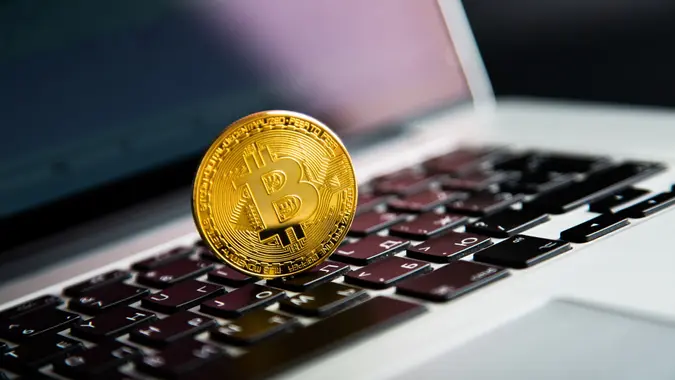What Is Bitcoin? Understanding the Basics of BTC and Cryptocurrency

Commitment to Our Readers
GOBankingRates' editorial team is committed to bringing you unbiased reviews and information. We use data-driven methodologies to evaluate financial products and services - our reviews and ratings are not influenced by advertisers. You can read more about our editorial guidelines and our products and services review methodology.

20 Years
Helping You Live Richer

Reviewed
by Experts

Trusted by
Millions of Readers
Bitcoin was the world’s first cryptocurrency and remains the best-known and largest digital coin by market cap.
The crypto revolution started on Jan. 3, 2009, when Satoshi Nakamoto — a presumed pseudonym for Bitcoin’s founder or founders — mined Block 0, or the Genesis Block, the first block on the Bitcoin blockchain.
A decentralized currency and payment system, Bitcoin operates independently of a government or central bank.
Exciting, volatile and often controversial, cryptocurrency, in general, and Bitcoin specifically, has evolved from an obscure and largely unknown niche to a trending fad to a utilitarian token to an accepted asset class, and finally, to a mainstream investment and medium of exchange.
Understanding Bitcoin
Bitcoin is the name of the world’s first, and still most recognizable cryptocurrency.
What Does BTC Mean?
BTC is the ticker symbol under which Bitcoin trades. People and businesses use Bitcoin to pay for products and services, but investors also buy, sell and trade it on exchanges like stocks. Also like stocks, those cryptocurrencies all have unique abbreviations that represent them on the exchanges that serve as marketplaces for investors.
Bitcoin’s is BTC.
What Are Bitcoins For?
Here are some of the ways Bitcoin has proven to be useful.
- Payments: People use Bitcoin for p2p payments and as a currency to pay for products and services. Businesses use it for b2b and vendor payments.
- Investments: Investors trade Bitcoin and thousands of other cryptocurrencies on specialized exchanges to grow their wealth, just like stocks — some for the long term, others in pursuit of short-term gains.
- Store of value: Some people and businesses use Bitcoin to retain their purchasing power and mitigate depreciation.
- Decentralized applications: Bitcoin serves a utilitarian function in powering and maintaining decentralized applications (dapps).
How Bitcoin Works
Before you can use, spend or invest in Bitcoin, you have to understand the basics of how it works.
Blockchain Technology
Bitcoin introduced the world to blockchain technology. Unlike traditional fiat currency, governments and central banks don’t issue and regulate Bitcoin. Instead, it relies on a computational process called mining to maintain a permanent record of transactions on a public digital ledger and to create new Bitcoins.
Those who perform this essential maintenance are called miners. They use specialized computers and software to solve complex mathematical problems that validate transactions and record them on the blockchain. It’s called Proof-of-Work (PoW) validation, and, when successful, miners are rewarded for their efforts with Bitcoin.
Bitcoin Wallets
To buy, sell, own, trade, spend, accept or otherwise utilize Bitcoin, you must set up a crypto wallet that supports Bitcoin to connect with the blockchain and access your holdings. Because of the anonymous, decentralized nature of cryptocurrency, security is of the utmost concern. The private keys that grant owners entry to their wallets can be lost forever, rendering the Bitcoin it secures permanently inaccessible.
- Hot wallets: Desktop, mobile and web wallets are connected to the internet. Therefore, they’re easily accessible from anywhere but vulnerable to hacking and breaches.
- Cold wallets: Hardware wallets and paper wallets are external and disconnected. They’re less convenient but more secure.
Bitcoin Transactions
Here are the fundamentals of what happens when people buy, sell, trade, receive, send and spend Bitcoin.
- The users’ wallets generate addresses that are unique to that transaction.
- The sender starts the transaction by inputting the recipient’s address and the amount to be sent.
- The transaction is relayed to the Bitcoin network for blockchain validation.
- Miners verify the exchange and bundle it into an inalterable “block” on the blockchain.
- Upon confirmation, the transaction is permanently recorded on the blockchain.
To facilitate this process, users pay transaction fees, which vary based on the priority level and data size of the transaction and network demand at the time it is executed.
Investing in Bitcoin
Some people use Bitcoin as a currency and payment system. Others invest in it to try to grow their wealth.
How to Buy Bitcoin
Users and investors can buy Bitcoins through digital marketplaces called cryptocurrency exchanges, where prices are set according to supply and demand. The most popular include:
- Coinbase
- Gemini
- Kraken
Some brokerages also offer Bitcoin trading, including Fidelity and Robinhood.
Storing and Securing Your Investment
Some hot wallets offer services like passkey recovery, but it is ultimately the user’s responsibility to secure their wallets and safeguard their holdings.
Bitcoin’s online security tutorial recommends the following:
- Be leery of any service offering to store your holdings online.
- Keep the bulk of your holdings or long-term investments in a secure cold wallet while keeping some for daily use or fast, mobile transactions in a convenient hot wallet.
- Back up your wallet regularly.
- Encrypt online backups.
- Choose a strong password that you’ll never forget — you can’t recover your holdings without it.
Risks and Volatility
Cryptocurrency is infamous for nerve-wracking price fluctuations that long rendered it a wild speculative investment in the eyes of many mainstream investors. Fidelity data confirms that Bitcoin is a highly volatile asset compared to more familiar offerings — roughly three times riskier than mainstream investments like commodities, small-cap stocks and REITs. It can be 10 times more volatile than safer bets like bonds.
However, Fidelity points out that dozens of mega-cap S&P 500 stocks have been more volatile than Bitcoin in recent years, including Nvidia, Meta and Tesla.
Even so, crypto is not for easily rattled investors — expect a wild ride of euphoric highs and startling lows.
Advantages and Disadvantages of Bitcoin
Here’s a look at the primary benefits and drawbacks.
Advantages
Bitcoin emerged from a free market philosophy that sought the democratization of currency. Its many advantages include transparency, security, relative anonymity and the potential for high returns. Also, its decentralized structure is resistant to manipulation and censorship.
Disadvantages
Bitcoin, however, is not without its drawbacks. The PoW model requires the endless running of energy-hog computers that consume vast resources and create an environmental hazard. Security is an immediate and personal responsibility that doesn’t have the benefit of a lost or stolen card hotline from your bank or credit card’s fraud department. Also, legal and regulatory uncertainties cloud the industry.
How Bitcoin Compares to Traditional Currencies
Bitcoin has a lot in common with traditional currency, but it is not the same thing as the money in your wallet.
Key Differences
Unlike the cash that you pull from an ATM or safeguard in a deposit account, cryptocurrency like Bitcoin has a fixed, finite supply. Unlike official currency, governments can’t print Bitcoin at will, which makes it more resistant to inflation. However, since cryptocurrency is not regulated or backed by a government, it is more volatile than traditional money.
Bitcoin vs. Other Cryptocurrencies
Bitcoin is so dominant that it’s literally in a class by itself. All of the thousands of non-Bitcoin cryptocurrencies — despite their many similarities with BTC — are known as “altcoins.”
Some of the biggest are Ethereum, Binance Coin, Litecoin and Tether.
All depend on blockchain technology, but some are purpose-built payment cryptocurrencies, while others serve as stablecoins, tokens or central bank digital currencies.
One of the primary differentiators is the consensus mechanism used to validate transactions. Bitcoin’s PoW mining mechanism is a labor-intensive process that’s slow and energy-inefficient. Instead, most altcoins use proof-of-stake (PoS) validation, which instead relies on coin holders to hold — or stake — their tokens on the blockchain to validate transactions.
The Future of Bitcoin
Bitcoin has displayed remarkable staying power over the decade and a half since Satoshi Nakamoto launched the cryptocurrency revolution. Once an exciting and trendy niche that inspired more skepticism than optimism, it’s clear now that Bitcoin is here to stay.
Mainstream Adoption
In a year-end retrospective, Forbes called 2024 the year that “took BTC mainstream.”
Bitcoin broke the long-elusive and hugely symbolic $100,000 in 2024 — but with the SEC approving 11 BTC-related ETFs and the nation electing a vocally pro-Bitcoin president, regulatory overhaul proved far more consequential than symbolism.
More than 1,000 businesses in 15 of America’s biggest cities now accept Bitcoin, adding to the more than 15,000 brands — including Walmart, Disney and Apple — that accept BTC as payment.
Technological Advancements
Rapid advancements in infrastructure and technology have helped Bitcoin break into the mainstream. For example, the Bitcoin Lightning Network bypasses block confirmation waits by using smart contracts for nearly instant transactions on an inexpensive, highly scalable, cross-blockchain platform.
Bitcoin’s Role in the Digital Economy
Perhaps most importantly, Bitcoin has the potential to revolutionize finance and commerce in the digital space. It serves as a currency, but Bitcoin is more than just a medium of exchange. It is fueling a rapid evolution in the financial services industry and emerging as a universal token for cross-border exchanges.
FAQ
Despite its move into the mainstream, Bitcoin is still unfamiliar to many who might benefit from using or investing in it. They can benefit from learning the answers to these frequently asked questions.- What is the purpose of Bitcoin?
- In 2008, Satoshi Nakamoto released a whitepaper outlining the philosophical purpose of Bitcoin, which debuted the following year. It XX a “trustless” currency that people could exchange in direct transactions that could be verified without a trusted intermediary like a government or central bank.
- How is Bitcoin different from traditional money?
- Unlike regular money, which the government can endlessly print and inject into the economy, there is a finite supply of Bitcoin, unlike standard currency
- Is Bitcoin a good investment?
- Bitcoin is a volatile and unpredictable investment that has gained — and lost — many people a lot of money. “Good” depends on your investment horizon, goals and risk tolerance.
- How secure is Bitcoin?
- Bitcoin holders have much more control over the security of their holdings than they do with the money that banks secure on their behalf. Your wallet discipline will largely determine how secure your Bitcoin is.
- Can Bitcoin be used for everyday purchases?
- Many retailers, e-commerce platforms and even some brick-and-mortar stores accept Bitcoin as payment.
 Written by
Written by  Edited by
Edited by 

























